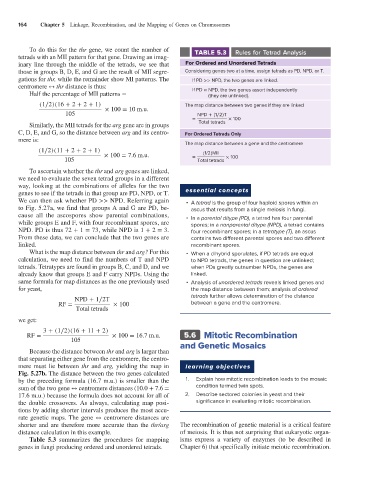Page 172 - Genetics_From_Genes_to_Genomes_6th_FULL_Part1
P. 172
164 Chapter 5 Linkage, Recombination, and the Mapping of Genes on Chromosomes
To do this for the thr gene, we count the number of TABLE 5.3 Rules for Tetrad Analysis
tetrads with an MII pattern for that gene. Drawing an imag-
inary line through the middle of the tetrads, we see that For Ordered and Unordered Tetrads
those in groups B, D, E, and G are the result of MII segre- Considering genes two at a time, assign tetrads as PD, NPD, or T.
gations for thr, while the remainder show MI patterns. The If PD >> NPD, the two genes are linked.
centromere ↔ thr distance is thus:
Half the percentage of MII patterns = If PD ≈ NPD, the two genes assort independently
(they are unlinked).
(1 2)(16 + 2 + 2 + 1) × 100 = 10 m.u. The map distance between two genes if they are linked
105 NPD + (1 2)T
= × 100
Similarly, the MII tetrads for the arg gene are in groups Total tetrads
C, D, E, and G, so the distance between arg and its centro- For Ordered Tetrads Only
mere is:
The map distance between a gene and the centromere
(1 2)(11 + 2 + 2 + 1) × 100 = 7.6 m.u. (1/2)MII
105 = Total tetrads × 100
To ascertain whether the thr and arg genes are linked,
we need to evaluate the seven tetrad groups in a different
way, looking at the combinations of alleles for the two
genes to see if the tetrads in that group are PD, NPD, or T. essential concepts
We can then ask whether PD >> NPD. Referring again • A tetrad is the group of four haploid spores within an
to Fig. 5.27a, we find that groups A and G are PD, be- ascus that results from a single meiosis in fungi.
cause all the ascospores show parental combinations, • In a parental ditype (PD), a tetrad has four parental
while groups E and F, with four recombinant spores, are spores; in a nonparental ditype (NPD), a tetrad contains
NPD. PD is thus 72 + 1 = 73, while NPD is 1 + 2 = 3. four recombinant spores; in a tetratype (T), an ascus
From these data, we can conclude that the two genes are contains two different parental spores and two different
linked. recombinant spores.
What is the map distance between thr and arg? For this • When a dihybrid sporulates, if PD tetrads are equal
calculation, we need to find the numbers of T and NPD to NPD tetrads, the genes in question are unlinked;
tetrads. Tetratypes are found in groups B, C, and D, and we when PDs greatly outnumber NPDs, the genes are
already know that groups E and F carry NPDs. Using the linked.
same formula for map distances as the one previously used • Analysis of unordered tetrads reveals linked genes and
for yeast, the map distance between them; analysis of ordered
NPD + 1 2T tetrads further allows determination of the distance
RF = × 100 between a gene and the centromere.
Total tetrads
we get:
3 + (1 2)(16 + 11 + 2)
RF = × 100 = 16.7 m.u. 5.6 Mitotic Recombination
105
and Genetic Mosaics
Because the distance between thr and arg is larger than
that separating either gene from the centromere, the centro-
mere must lie between thr and arg, yielding the map in learning objectives
Fig. 5.27b. The distance between the two genes calculated
by the preceding formula (16.7 m.u.) is smaller than the 1. Explain how mitotic recombination leads to the mosaic
sum of the two gene ↔ centromere distances (10.0 + 7.6 = condition termed twin spots.
17.6 m.u.) because the formula does not account for all of 2. Describe sectored colonies in yeast and their
the double crossovers. As always, calculating map posi- significance in evaluating mitotic recombination.
tions by adding shorter intervals produces the most accu-
rate genetic maps. The gene ↔ centromere distances are
shorter and are therefore more accurate than the thr/arg The recombination of genetic material is a critical feature
distance calculation in this example. of meiosis. It is thus not surprising that eukaryotic organ-
Table 5.3 summarizes the procedures for mapping isms express a variety of enzymes (to be described in
genes in fungi producing ordered and unordered tetrads. Chapter 6) that specifically initiate meiotic recombination.

